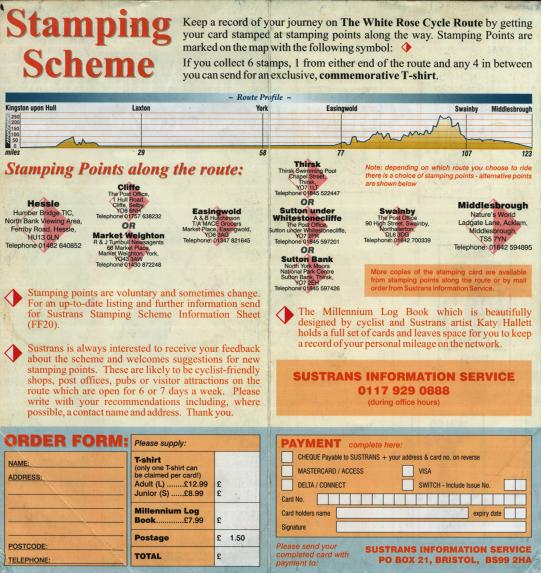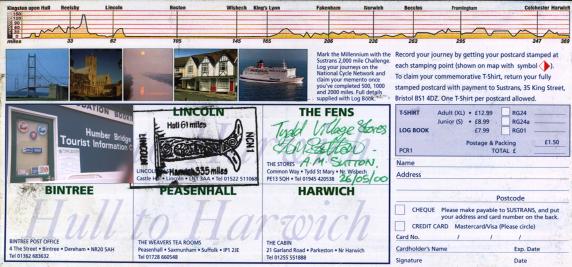Middlesbrough to London
Tuesday 23 - Sunday 28 May 2000
In May 2000 I was due to speak at a conference in Glasgow, and after that had an invitation to visit a lab run by a friend of mine at the University of Sunderland. What a perfect excuse, I thought, for a cycling trip from the North of England back to London. I decided to try out Britain's new National Cycle Network, a project of the nonprofit cycling organisation Sustrans. The plan was to cycle the length of the White Rose Cycle Route from Middlesbrough (just south of Sunderland) to Hull, followed by a portion of the Hull to Harwich Cycle Route as far as the Fens, and then to cut south through Cambridgeshire and Hertfordshire to London. Though the Network's official opening wasn't till 21 June, the routes were already in operation.
Loath to bear the expense and risk of entrusting my bicycle to an airline, I had rather settled on hiring a bicycle in London and bringing it to Sunderland by train. Poking about the web, though, I found an excellent price on a Giant X-500 hybrid from Cycle World in Sunderland, which made it worth my while to buy the bicycle outright so that I could keep it in the UK for future trips.
Although Cycle World didn't reply to the email that I sent, when I telephoned them they were happy to hold their last 19.5" X-500 frame for my arrival a month hence -- they didn't even ask for a card number! I showed up at Cycle World on Monday 22 May, and found the bicycle waiting for me. The people who ran the shop said that they had a lot of people coming through on the C2C route, which runs across the north of England from Whitehaven and Workington to Sunderland and Newcastle -- I must try that sometime.
The people at Cycle World were friendly and helpful and gave me a good deal, and I recommend them to any other riders who may be passing through Sunderland. My only regret is the matter of the tubes that they used as original equipment. The tubes are made by a Chinese company called Kenda, and they seem rather regularly to pop at the seams. I blew one, on the rear wheel, whilst touring around Sunderland that afternoon. Its replacement, also a Kenda, popped on my second day out, just south of Cliffe. The last of the Kenda tubes, on the front wheel, met its end later that week near the M25 just outside London.
 Before leaving Sunderland I took the bike out for a tour around the city. Sunderland is an old industrial town, and the technical focus of the University of Sunderland (formerly Sunderland Polytechnic) reflects that history. With the relative decline of the shipping industry, the town seems to suffer from a sort of post-industrial malaise. Though much of the land along the river Wear is occupied by idle shipping cranes, there are some nice spots, such as this view looking inland from the river's south bank.
Before leaving Sunderland I took the bike out for a tour around the city. Sunderland is an old industrial town, and the technical focus of the University of Sunderland (formerly Sunderland Polytechnic) reflects that history. With the relative decline of the shipping industry, the town seems to suffer from a sort of post-industrial malaise. Though much of the land along the river Wear is occupied by idle shipping cranes, there are some nice spots, such as this view looking inland from the river's south bank.
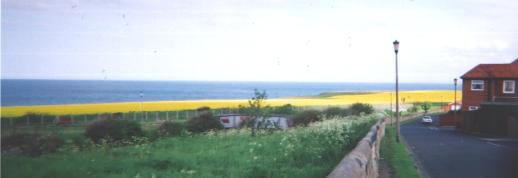 From the river I headed south and east to the coast. After getting through the industrial areas on this side of Sunderland, I was rewarded with a stunning view of brilliant yellow gorse growing alongside a coastal track at the edge of the North Sea. (The photograph doesn't do justice to it.)
From the river I headed south and east to the coast. After getting through the industrial areas on this side of Sunderland, I was rewarded with a stunning view of brilliant yellow gorse growing alongside a coastal track at the edge of the North Sea. (The photograph doesn't do justice to it.)
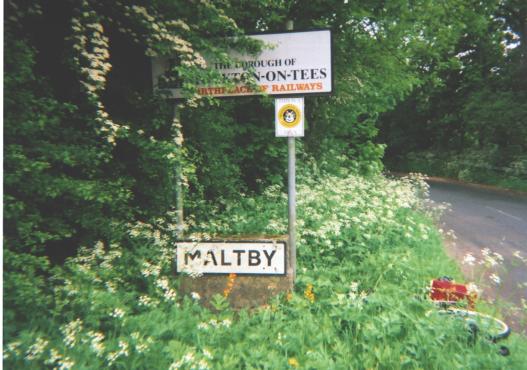 The next morning, I set off. My friend Paul insists on driving me as far as Middlesbrough, the beginning of the White Rose route, since, he says, the roads between Sunderland and Middlesbrough aren't friendly to bicycles. At Middlesbrough I find the first stamping point for the White Rose route, Nature's World. Nature's World is a privately run park promoting environmentally sustainable ways of living.
The next morning, I set off. My friend Paul insists on driving me as far as Middlesbrough, the beginning of the White Rose route, since, he says, the roads between Sunderland and Middlesbrough aren't friendly to bicycles. At Middlesbrough I find the first stamping point for the White Rose route, Nature's World. Nature's World is a privately run park promoting environmentally sustainable ways of living.
On the outskirts of Middlesbrough I discover a rule that will hold throughout the northern portion of the route: trust the map, not the signposts. Several critical turns are not signed, and a few that are signed have their signs pointing in wrong or ambiguous directions. (The signage improves south of Hull, but the maps still are an invaluable resource.) After catching up with a group of cyclists from the Sellafield plutonium reprocessing plant who are (ironically) on a charity ride for cancer research, I pass through Maltby, where some of my ancestors came from, and proceed to Swainby, a village at the edge of the North York Moors National Park, where I stop for lunch at The Blacksmith's Arms, and also collect the next route stamp at the local post office.
 The terrain in the moors is difficult, and the wind lashes the hillsides of Osmotherly Moor. Few things here grow taller than the sheep that dot the fields. Due to poor signage around Thimbleby, I end up turning west and crossing the A19. If I come this way again I'll have to try the eastern route, through the centre of the moors. I head south through Borrowby to rejoin the route, then collect the next stamp at Thirsk. By the time I arrive at Easingwold the shops have closed for the day, so I'm unable to collect that stamp. (Instead, I take a photograph of the marketplace to prove that I've been there, and paste it onto the stamping card.)
The terrain in the moors is difficult, and the wind lashes the hillsides of Osmotherly Moor. Few things here grow taller than the sheep that dot the fields. Due to poor signage around Thimbleby, I end up turning west and crossing the A19. If I come this way again I'll have to try the eastern route, through the centre of the moors. I head south through Borrowby to rejoin the route, then collect the next stamp at Thirsk. By the time I arrive at Easingwold the shops have closed for the day, so I'm unable to collect that stamp. (Instead, I take a photograph of the marketplace to prove that I've been there, and paste it onto the stamping card.)
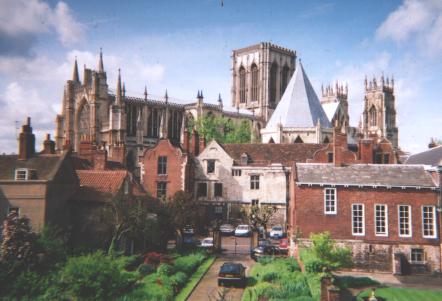 On the northern outskirts of York begins a cycle trail that takes me right past the youth hostel, where I stay for the night. (I rang ahead from Easingwold, and got the very last available bed.) At the hostel I run into the Sellafield crew again -- they're also continuing south but will be taking a more westerly route, through Derby. The next morning I pick up some good Michelin tubes at Bob Trotter Cycles, just inside the old city wall near the Monk's Gate. York is a pleasant town that has retained its medieval layout. Its city centre reminds me of Cambridge, actually, although without such a large university its demographics are a bit different. I take some time to explore the city on foot before setting off the next morning.
On the northern outskirts of York begins a cycle trail that takes me right past the youth hostel, where I stay for the night. (I rang ahead from Easingwold, and got the very last available bed.) At the hostel I run into the Sellafield crew again -- they're also continuing south but will be taking a more westerly route, through Derby. The next morning I pick up some good Michelin tubes at Bob Trotter Cycles, just inside the old city wall near the Monk's Gate. York is a pleasant town that has retained its medieval layout. Its city centre reminds me of Cambridge, actually, although without such a large university its demographics are a bit different. I take some time to explore the city on foot before setting off the next morning.

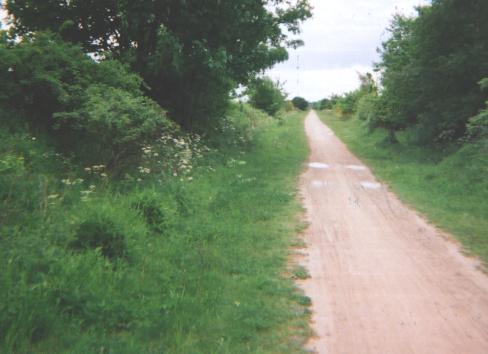 The route south from York is a converted railway which had fallen into disuse with the decline of coal mining in the area. As a result the grades are gentle and all the roads are crossed on bridges. York University have put together a scale model of the solar system along this route, and at my normal speed on the rather flat terrain, I'm travelling at about ten times the scaled speed of light.
The route south from York is a converted railway which had fallen into disuse with the decline of coal mining in the area. As a result the grades are gentle and all the roads are crossed on bridges. York University have put together a scale model of the solar system along this route, and at my normal speed on the rather flat terrain, I'm travelling at about ten times the scaled speed of light.
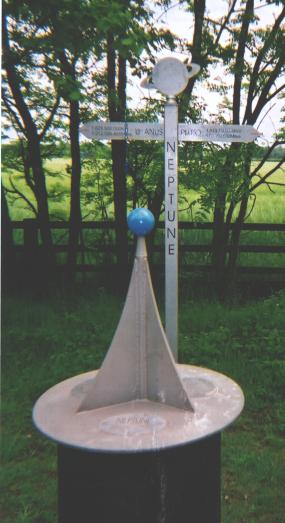
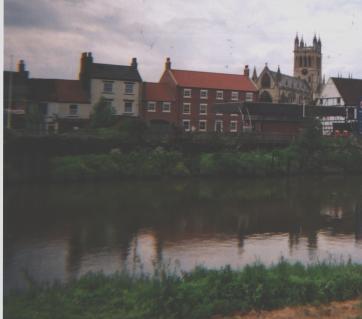 The railway route ends just north of Selby, where the route turns and follows farm tracks along the river Ouse. The eastward turn away from the Ouse is within view of the cooling towers of a large power plant. It isn't signed at all, and one has to identify it from the map. In Cliffe, I stop at the post office to collect the next stamp.
The railway route ends just north of Selby, where the route turns and follows farm tracks along the river Ouse. The eastward turn away from the Ouse is within view of the cooling towers of a large power plant. It isn't signed at all, and one has to identify it from the map. In Cliffe, I stop at the post office to collect the next stamp.
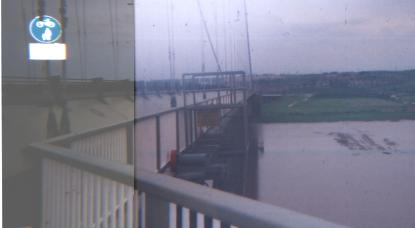 At the Humber Bridge, on the northern outskirts of Kingston-upon-Hull, I transfer from the White Rose route to the Hull-to-Harwich route. By the time I arrive at the bridge, the stamping point there is closed for the day, so I again I substitute with a photograph. In Barton-on-Humber, a very bicycle-friendly town, I stop on George Street for dinner at the George Hotel. They offer a selection of freshly cooked meals at a price that can't be beat -- £2.99 -- along with some good ales and my favourite, cider. With the light beginning to fade, and no convenient woods for the next twenty miles or so, I decide to stop for the night under the cover of Hendale Wood. At about 4.30 it's light again, and I set off through Beelsby, across the wolds to Market Rasen and thence to Lincoln. Pain in my left knee has begun to bother me, but it responds to 600mg of ibuprofen. (I'm a bit dismayed by this development -- I never used to have trouble with my knee, and though I feel full of energy, I have to stop and walk at times when the drug starts to wear off.)
At the Humber Bridge, on the northern outskirts of Kingston-upon-Hull, I transfer from the White Rose route to the Hull-to-Harwich route. By the time I arrive at the bridge, the stamping point there is closed for the day, so I again I substitute with a photograph. In Barton-on-Humber, a very bicycle-friendly town, I stop on George Street for dinner at the George Hotel. They offer a selection of freshly cooked meals at a price that can't be beat -- £2.99 -- along with some good ales and my favourite, cider. With the light beginning to fade, and no convenient woods for the next twenty miles or so, I decide to stop for the night under the cover of Hendale Wood. At about 4.30 it's light again, and I set off through Beelsby, across the wolds to Market Rasen and thence to Lincoln. Pain in my left knee has begun to bother me, but it responds to 600mg of ibuprofen. (I'm a bit dismayed by this development -- I never used to have trouble with my knee, and though I feel full of energy, I have to stop and walk at times when the drug starts to wear off.)
After the difficulty with the knee I arrive in Lincoln at about 10am, and stay for a long day. I consider spending the night, but as the hostel is full that decision is made for me. I stop at Lincoln Castle, whose wall affords a panoramic view of the town below and also of Lincoln Cathedral, an elaborate building which has been in a state of construction or repair for the past nine centuries. I collect a route stamp at the castle shop, then climb the steps to the keep, whose low walls -- partially dismantled during the English civil war -- admit the afternoon sun. The castle is home to the original Lincoln copy of the Magna Carta, and flocks of schoolchildren are trooping through to hear about it. A guide explains to them, `This is the Magna Carta. It is the basis of your freedom and democracy.' -- true enough, I suppose, if you happen to be a baron or an earl or other landed nobility, but the rest of us depend more on the body of common law that has accrued since then. It's amusing to hear this sort of rhetoric in England because the same empty phrases are applied to the American Constitution and Declaration of Independence, neither of which has really been lived up to.
From Lincoln I continue south into the very flat country of the Fens. The only factor to slow me down here is the wind, which blows in from the sea ferociously. In Tattershall Bridge I stop for dinner at the Royal Oak, a very friendly, proper country pub. I've arrived a bit before opening time so at first I'm the only person in the place. Pete, the proprietor, is an interesting character. He took a degree in chemistry but then went into business with the pub. He's fascinated with the US, and asks me about its educational system and its regional cultures. We compare New York versus the South in the US to London versus the Fens in England -- in each case, the city is full of people rushing about in a get-it-done-yesterday frenzy whereas the country is easy-going. Anyone who cycles this route should stop in at the Royal Oak for a pint and conversation -- it's a great place to have a break and to discover the Fens' relaxed way of life.
I stop for the night at the Lochiel Guest House, a bed-and-breakfast on the road into Boston, then visit the Village Stores in Tydd St Mary the next morning to collect the next route stamp. The proprietor can't find her stamp, so instead she signs my stamping card. I continue across the Fosdyke Bridge, through Holbeach, and into Wisbech. Departing from the Hull-to-Harwich route, from the roundabout in Wisbech I follow the sign for the Peterborough road and continue on the B1101 through Elm and into March, where I turn left onto the high street and then proceed straight 180° through a roundabout into Wimblington. (Cyclists following this route should ignore the signs for Wimblington at the 90° position on this roundabout; the road in question is the A142 bypass, not friendly to bicycles and actually a bit longer than the smaller road.) I continue straight through Wimblington and Doddington, then at the roundabout at the edge of Chatteris I turn 270° onto the major road just to the right of the Esso station. The next left leads to the city centre, where I follow the signs onto the Somersham road. At Somersham I turn left onto the B1050 through Earith. At the second left in Willingham, I follow a sign for Rampton and Cottenham. At Cottenham I turn right onto the B1049, which runs through Histon and into Cambridge. On the other side of Cambridge, I stop at the youth hostel.
The next day is spent in Cambridge, entirely off the bicycle. The weather still consists of periods of sun punctuated with brief thunderstorms, so I find myself alternating between walking around the town and holing up in the University's various museums. Although its position between London and the Fens make Cambridge a logical place to stop, it is a bit ironic to be back here without having any business with the University. Unlike most American universities, Cambridge is rather aloof from the town that surrounds it. With most of its people and events enclosed within the various colleges, it's difficult for an outsider to participate in the life of the place. I would enjoy spending some more time here, but I don't think I'll be back unless and until I have a reason to stay.
In the morning I head out of Cambridge on the A1307 (Hills Road), straight through the roundabout at Addenbrooke's Hospital and then on the second right, through Great Shelford and into Little Shelford. At Little Shelford I turn left onto a road that parallels the River Cam, the railway, and the M11, passing through Whittlesford, Duxford, and Ickleton before joining the B1383 at Great Chesterford. Unlike that of the previous few days, this morning's rain has been constant and rather cold. By the time I reach Stansted my hands are so cold that it's becoming difficult to grip the handlebars, and I resolve to stop in Bishop's Stortford for a respite if the weather doesn't improve. Fortunately, by the time I arrive in Bishop's Stortford the sun is coming out, and the rest of the day is fine except for a few very brief storms. At Bishop's Stortford the B1383 joins the A1184. I cycle along the path at the side of the A1184 to Harlow, where I take a left in order to detour around the busy roundabouts at the centre of the town, then rejoin the A1184 till the B1383 splits off again at the M11. I stop here at a roadside fast-food store that mostly caters to M11 traffic, a far cry from the village pubs at which I've been taking most of my meals.
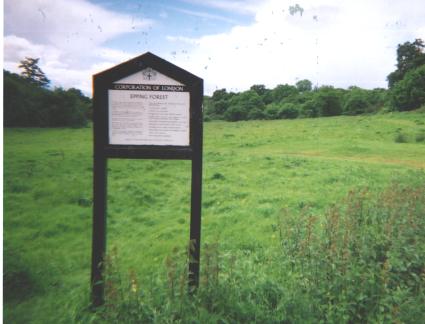 The B1383 continues through Epping, and at the roundabout I proceed 270° onto the A121 and then immediately take a left into Epping Forest. From the car park, I make my way onto a bridleway southward through the forest. It's a bit muddy after the rain, and there are a few flooded sections, but it's nothing that I can't manage on the hybrid. Coming out near the southern edge of Epping Forest, I join the A104, and then with the London A to Z as my guide I proceed south through Woodford, Wanstead, and East Ham to the free ferry at Woolwich. On the south bank of the Thames I turn westward. I'm trying to follow the Thames Path but this proves futile, as the path disappears and reappears with no clear guide as to how to fill the discontinuities. I pass by the Royal Observatory at Greenwich, and the Millennium Dome, which everyone says is overpriced and rather Disneyesque. I pass through Lambeth, Battersea, Clapham, Wandsworth, Richmond, Kingston-on-Thames (full of bank holiday weekend revellers - not pleasant), Surbiton, Esher, and Oxshott, and then traverse Oxshott Heath to Cobham, where my journey ends.
The B1383 continues through Epping, and at the roundabout I proceed 270° onto the A121 and then immediately take a left into Epping Forest. From the car park, I make my way onto a bridleway southward through the forest. It's a bit muddy after the rain, and there are a few flooded sections, but it's nothing that I can't manage on the hybrid. Coming out near the southern edge of Epping Forest, I join the A104, and then with the London A to Z as my guide I proceed south through Woodford, Wanstead, and East Ham to the free ferry at Woolwich. On the south bank of the Thames I turn westward. I'm trying to follow the Thames Path but this proves futile, as the path disappears and reappears with no clear guide as to how to fill the discontinuities. I pass by the Royal Observatory at Greenwich, and the Millennium Dome, which everyone says is overpriced and rather Disneyesque. I pass through Lambeth, Battersea, Clapham, Wandsworth, Richmond, Kingston-on-Thames (full of bank holiday weekend revellers - not pleasant), Surbiton, Esher, and Oxshott, and then traverse Oxshott Heath to Cobham, where my journey ends.

I've made some low-resolution scans of the route maps produced by Sustrans. To obtain a map that's detailed enough for finding your way, and to support Sustrans's continuing development of cycle routes, cyclists should buy their own copies of The White Rose Cycle Route and Hull to Fakenham. Click anywhere on the map to bring up the next map in the series. The route begins at Middlesbrough:

 Before leaving Sunderland I took the bike out for a tour around the city. Sunderland is an old industrial town, and the technical focus of the University of Sunderland (formerly Sunderland Polytechnic) reflects that history. With the relative decline of the shipping industry, the town seems to suffer from a sort of post-industrial malaise. Though much of the land along the river Wear is occupied by idle shipping cranes, there are some nice spots, such as this view looking inland from the river's south bank.
Before leaving Sunderland I took the bike out for a tour around the city. Sunderland is an old industrial town, and the technical focus of the University of Sunderland (formerly Sunderland Polytechnic) reflects that history. With the relative decline of the shipping industry, the town seems to suffer from a sort of post-industrial malaise. Though much of the land along the river Wear is occupied by idle shipping cranes, there are some nice spots, such as this view looking inland from the river's south bank.
 From the river I headed south and east to the coast. After getting through the industrial areas on this side of Sunderland, I was rewarded with a stunning view of brilliant yellow gorse growing alongside a coastal track at the edge of the North Sea. (The photograph doesn't do justice to it.)
From the river I headed south and east to the coast. After getting through the industrial areas on this side of Sunderland, I was rewarded with a stunning view of brilliant yellow gorse growing alongside a coastal track at the edge of the North Sea. (The photograph doesn't do justice to it.)
 The next morning, I set off. My friend Paul insists on driving me as far as Middlesbrough, the beginning of the White Rose route, since, he says, the roads between Sunderland and Middlesbrough aren't friendly to bicycles. At Middlesbrough I find the first stamping point for the White Rose route, Nature's World. Nature's World is a privately run park promoting environmentally sustainable ways of living.
The next morning, I set off. My friend Paul insists on driving me as far as Middlesbrough, the beginning of the White Rose route, since, he says, the roads between Sunderland and Middlesbrough aren't friendly to bicycles. At Middlesbrough I find the first stamping point for the White Rose route, Nature's World. Nature's World is a privately run park promoting environmentally sustainable ways of living.
 The terrain in the moors is difficult, and the wind lashes the hillsides of Osmotherly Moor. Few things here grow taller than the sheep that dot the fields. Due to poor signage around Thimbleby, I end up turning west and crossing the A19. If I come this way again I'll have to try the eastern route, through the centre of the moors. I head south through Borrowby to rejoin the route, then collect the next stamp at Thirsk. By the time I arrive at Easingwold the shops have closed for the day, so I'm unable to collect that stamp. (Instead, I take a photograph of the marketplace to prove that I've been there, and paste it onto the stamping card.)
The terrain in the moors is difficult, and the wind lashes the hillsides of Osmotherly Moor. Few things here grow taller than the sheep that dot the fields. Due to poor signage around Thimbleby, I end up turning west and crossing the A19. If I come this way again I'll have to try the eastern route, through the centre of the moors. I head south through Borrowby to rejoin the route, then collect the next stamp at Thirsk. By the time I arrive at Easingwold the shops have closed for the day, so I'm unable to collect that stamp. (Instead, I take a photograph of the marketplace to prove that I've been there, and paste it onto the stamping card.)
 On the northern outskirts of York begins a cycle trail that takes me right past the youth hostel, where I stay for the night. (I rang ahead from Easingwold, and got the very last available bed.) At the hostel I run into the Sellafield crew again -- they're also continuing south but will be taking a more westerly route, through Derby. The next morning I pick up some good Michelin tubes at Bob Trotter Cycles, just inside the old city wall near the Monk's Gate. York is a pleasant town that has retained its medieval layout. Its city centre reminds me of Cambridge, actually, although without such a large university its demographics are a bit different. I take some time to explore the city on foot before setting off the next morning.
On the northern outskirts of York begins a cycle trail that takes me right past the youth hostel, where I stay for the night. (I rang ahead from Easingwold, and got the very last available bed.) At the hostel I run into the Sellafield crew again -- they're also continuing south but will be taking a more westerly route, through Derby. The next morning I pick up some good Michelin tubes at Bob Trotter Cycles, just inside the old city wall near the Monk's Gate. York is a pleasant town that has retained its medieval layout. Its city centre reminds me of Cambridge, actually, although without such a large university its demographics are a bit different. I take some time to explore the city on foot before setting off the next morning.

 The route south from York is a converted railway which had fallen into disuse with the decline of coal mining in the area. As a result the grades are gentle and all the roads are crossed on bridges. York University have put together
The route south from York is a converted railway which had fallen into disuse with the decline of coal mining in the area. As a result the grades are gentle and all the roads are crossed on bridges. York University have put together 
 The railway route ends just north of Selby, where the route turns and follows farm tracks along the river Ouse. The eastward turn away from the Ouse is within view of the cooling towers of a large power plant. It isn't signed at all, and one has to identify it from the map. In Cliffe, I stop at the post office to collect the next stamp.
The railway route ends just north of Selby, where the route turns and follows farm tracks along the river Ouse. The eastward turn away from the Ouse is within view of the cooling towers of a large power plant. It isn't signed at all, and one has to identify it from the map. In Cliffe, I stop at the post office to collect the next stamp.
 At the
At the 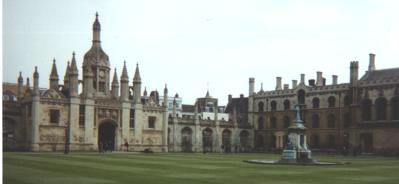
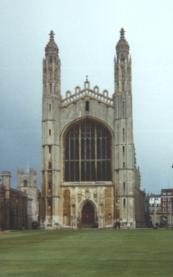
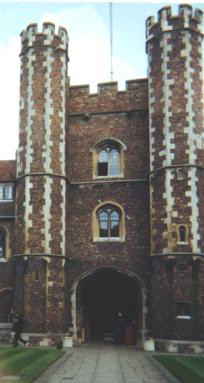
 The B1383 continues through Epping, and at the roundabout I proceed 270° onto the A121 and then immediately take a left into Epping Forest. From the car park, I make my way onto a bridleway southward through the forest. It's a bit muddy after the rain, and there are a few flooded sections, but it's nothing that I can't manage on the hybrid. Coming out near the southern edge of Epping Forest, I join the A104, and then with the London A to Z as my guide I proceed south through Woodford, Wanstead, and East Ham to the free ferry at Woolwich. On the south bank of the Thames I turn westward. I'm trying to follow the Thames Path but this proves futile, as the path disappears and reappears with no clear guide as to how to fill the discontinuities. I pass by the Royal Observatory at Greenwich, and the Millennium Dome, which everyone says is overpriced and rather Disneyesque. I pass through Lambeth, Battersea, Clapham, Wandsworth, Richmond, Kingston-on-Thames (full of bank holiday weekend revellers - not pleasant), Surbiton, Esher, and Oxshott, and then traverse Oxshott Heath to Cobham, where my journey ends.
The B1383 continues through Epping, and at the roundabout I proceed 270° onto the A121 and then immediately take a left into Epping Forest. From the car park, I make my way onto a bridleway southward through the forest. It's a bit muddy after the rain, and there are a few flooded sections, but it's nothing that I can't manage on the hybrid. Coming out near the southern edge of Epping Forest, I join the A104, and then with the London A to Z as my guide I proceed south through Woodford, Wanstead, and East Ham to the free ferry at Woolwich. On the south bank of the Thames I turn westward. I'm trying to follow the Thames Path but this proves futile, as the path disappears and reappears with no clear guide as to how to fill the discontinuities. I pass by the Royal Observatory at Greenwich, and the Millennium Dome, which everyone says is overpriced and rather Disneyesque. I pass through Lambeth, Battersea, Clapham, Wandsworth, Richmond, Kingston-on-Thames (full of bank holiday weekend revellers - not pleasant), Surbiton, Esher, and Oxshott, and then traverse Oxshott Heath to Cobham, where my journey ends.


